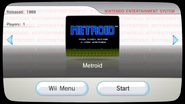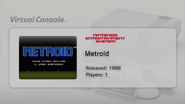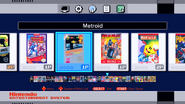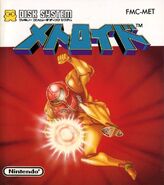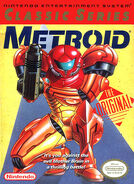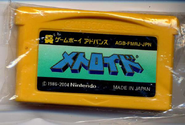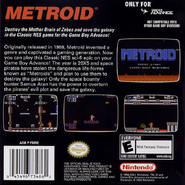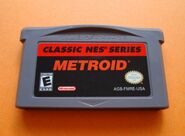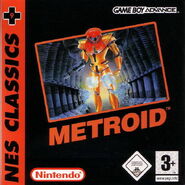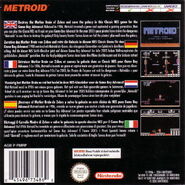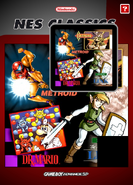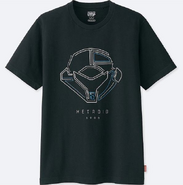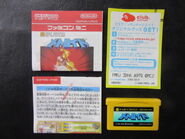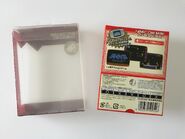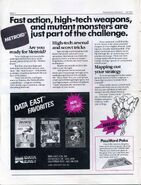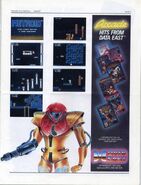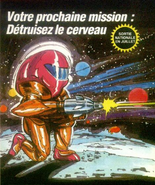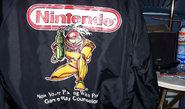| This is a featured article. |
| This article is written from the Real Life point of view |
- This article is about the first game in the series. For all other uses, see Metroid (Disambiguation).
Metroid (メトロイド Metoroido) is the first game in the Metroid series. It was released first for the Famicom Disk System on August 6, 1986, and later for the Nintendo Entertainment System in August 1987 in North America and in Europe on January 15, 1988. The game was produced by Gunpei Yokoi and was directed by Yoshio Sakamoto, with the music by Hirokazu Tanaka. The game was known for its eerie sci-fi flavor. Metroid would be remade for the Game Boy Advance under the title Metroid: Zero Mission, which updated the graphics, expanded the original plot and added new areas and abilities to the game, and even included the original version of the game being an unlockable feature upon completion. The original Metroid was also ported onto its own cartridge in the Classic NES Series, and later released on the Wii's Virtual Console on August 13, 2007.[2][3] Metroid was one of the 10 NES games that were re-released on the Nintendo eShop as part of the Ambassador Program, where people who owned a Nintendo 3DS before the price drop could get 10 NES games and 10 Game Boy Advance games for free. Metroid was later released on the Nintendo eShop to the public on March 1, 2012.
Story
In the year 2000 C.C. (Cosmic Calendar) the leaders of various planets united in order to form a congress that became known as the Galactic Federation in an attempt to construct a fair and structured universe that would enable society to grow and prosper. Under the guidance of this new federation, the individuals of the planets began to associate with each other and a new civilization began to develop. Various leaps in technology for transportation were created, such as interstellar spaceships, and society flourished through the use of such expansion.
Note: According to Metroid and Metroid II: Return of Samus's manuals, the year of the Galactic Federation formation was the year 2000.[4][5] In Metroid: Zero Mission's manual, the year of the Galactic Federation formation was 2003.[6]
At this time, Earth came into contact with individuals from these other worlds and the advanced technology that these people possessed was shared with the humans of Earth. All seemed well in this new society. However, devious groups known as "Space Pirates" began to attack the spaceships in the hopes of looting valuable goods from them and striking fear in the hearts of the people. In order to counter these attacks, the Federal Bureau set up a new combat force known as the Federal Police. Yet the pirates were extremely difficult to battle in the depths of space, even with the advanced technology of the Federation. Thus, they recruited a group of courageous individuals who became known as "Space Hunters", equipped with the best weapons available. The Federation provided huge financial bonuses to the Hunters in reward for hunting down and destroying the pirates.
It is now the year 20X5 C.C., and the universe has continued to develop while battles still rage throughout space. Recently, reports have indicated that a spaceship is traveling with a capsule containing an unknown life-force from the deserted planet SR388. This ship has been attacked and seized by the Space Pirates. While research about this life-form, currently in hibernation, is incomplete, it is known that exposure to beta rays for 24 hours will cause it to multiply. Some scientists believe that this life-form may have been the cause of destruction of life on SR388. The Chozo called this being a "Metroid" and the mere thought of it being in the hands of pirates is utterly disturbing to the human scientists. If the Pirates learned how to multiply this organism and use it as a biological weapon, the cost of lives could be overwhelming. The Federation launched search teams to find the Pirates and were fortunate to discover that their base was located deep within the planet Zebes. However, none of the forces are strong enough to take the pirates down.
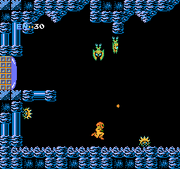
Samus Aran surrounded by enemies near the start of the game.
During this outside battle, operations to multiply the Metroid within the Space Pirates' headquarters were soon becoming a reality. Desperate for a solution, the Federation decided that the only option left was to attempt to infiltrate Zebes and destroy the leader of the Space Pirates, "Mother Brain." To make matters difficult, the structure of the planet Zebes is a natural fortress that consists of a large maze. Scattered throughout the maze are various traps and allies of the Space Pirates. This mission clearly requires a special individual to complete, and so the federation has selected the most dominating Space Hunter of the entire organization: Samus Aran.
Samus, though human, has a cybernetic suit built by the Chozo, thus providing her with a strange power. She has, to this date, completed many missions considered impossible, and her suit has the power to withstand lethal attacks, while providing many itself. Samus makes her way through the fortress-planet Zebes, collecting weapon and health upgrades, advancing to new areas, defeating Kraid, Ridley, and Mother Brain, and, in the end, destroys all Metroids on Zebes.
Gameplay
Metroid provided one of the first highly nonlinear game experiences on a home console. The basic gameplay is a mix of action adventure and platform shooter. Samus begins with a very limited amount of power-ups, and must explore the large areas to achieve the next "locked" or unreachable area. Because the game world is presented in one multi-screened "level," there are often areas that can be reached before they were meant to be by more experienced players. In this and later games in the Metroid series, this openness would lead to speed runs.
Areas
Metroid contains a major programming glitch that creates several rooms that are not built into the game. At first, they were thought to be areas hidden for the best of players. The only problem is that if this were true, then the game itself would hold the record for using the most memory of any NES games (556.5 kb). In fact, if the player were to include normal areas and hidden worlds, then the hidden worlds take up 77% of the planet. They can only be accessed by using the Door-Jump/Wall-Door Glitch, which allows Samus to be trapped in any hatch. It was only later that players discovered that these rooms don't take up memory on the cartridge, but are created spontaneously due to programming oversights (particularly having to do with how the elevator system works).
Once the player has begun the Door-Jump Glitch, they can jump to go up through the walls and reach these "hidden" worlds. Inside are a number of enemies corresponding to the current map (Brinstar, Norfair, etc.), including frozen, invincible Zeebetites and Mother Brains. Also, there are glitch hatches (they lead nowhere and cause damage when entered) and glitch walls (same sound effect as magma). These areas have become a curiosity, and all exploration and mapping of them stopped once their origin was discovered.
The reasoning behind the glitch is actually a quite simple. It works because the entire map is on a single grid. So in many instances, rooms in Norfair are directly above rooms in Ridley's Hideout, etc. The elevators are what tell the game to switch which area to pull data from. However, since players are (for example) moving through the wall from Ridley's Hideout into Norfair without using an elevator, the switch never takes place. The "hidden worlds" take place because each area is comprised of only a given number of rooms (which is why some commonly look the same) that are represented by a hex number. Since these hex numbers are not unique to each area, all areas will have a room 07, a room 19, or a room 2A, etc. When the player moves through the wall from (for example) Ridley's Hideout to Norfair, even though they are in the portion of the map that is normally Norfair, the room data is still set to Ridley's Hideout. All the room numbers are still the same, but room 12 may be a normal hallway in Norfair, yet the boss room in Ridley's Hideout. Players generally become stuck in the Hidden Worlds when a room designed for a horizonal hallway is swapped with a room designed for a vertical shaft with no doors.
The original programmers simply never expected players to be able to pass from one area to the other without using the elevators and it's only by random chance that there were enough door/hallway connections made that allowed players to explore.
Development
Metroid, originally called "Space Hunter" during development,[7] is notable for featuring a female protagonist, despite many games having a male protagonist at that time. However, as pointed above, the player would only know this if he/she completed the game in under 5 hours. The instruction manual specifically stated that Samus's identity was "shrouded in mystery". However, the booklet did at some points use masculine pronouns ('He', 'Him', and 'His') in reference to Samus, six times on page 7 alone.[8]
The player's manual included with the game presents the term "Metroid" as both singular and plural, though this has changed, causing "Metroids" to be the plural.
Password system
Metroid was one of the first games to use a password system for saving game information between play sessions, and the only Metroid game to do so. The original game released for the Famicom/Famicom Disk System allowed saving of games on the disk, but the North American release was in NES cartridge form and didn't implement battery backed memory, unlike The Legend of Zelda.
Metroid presents gamers with a password when Samus dies. Passwords are normally entered via the title screen, where the options "Start" and "Continue" are given. Continue leads to a screen where players can enter the password they have received at the end of the last game. After doing so, the gamer can continue playing, starting from the location at which they ended the game with the same powerups and progress they had before. However, many gamers disliked this password system and found it inconvenient, causing Metroid II: Return of Samus to use a battery backed save system.
JUSTIN BAILEY
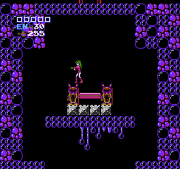
Samus's appearance after using the JUSTIN BAILEY code.
JUSTIN BAILEY refers to a famous Metroid password that gives the player nearly all the power-ups in the game, and allows them to use Samus in a pink leotard rather than her armored suit. However, the difference is purely visual as Samus has the same abilities and takes the same amount of damage from enemies that she would if she were wearing her suit.
The password starts the player in Norfair as an armorless Samus with five empty Energy Tanks, two hundred and five missiles, the Varia Suit, the Hi-Jump Boots, the Screw Attack, and the Wave Beam. Both bosses have been defeated and the path to Tourian has been opened. However, the player must still find the Ice Beam as the password does not give it and the beam is highly recommended to defeat the Metroids in Tourian. A final Energy Tank can also be obtained before fighting Mother Brain.
There are many theories regarding the password. For example, Justin Bailey was originally thought to be one of the creators of the game, but no such name appears in the game credits. It is also often said that the Justin Bailey code was a reference to an English or Australian term for a bathing suit. Bathing suits were, according to this rumor, referred to as "bailies," so "Justin Bailey" would more accurately be rendered as "Just In (a) Bailey", which is what Samus appears to wear when the code is used. However, Samus' outfit with this code is a leotard, not a bathing suit, and "bailey" is not actually slang for "bathing suit" anywhere in the world.
It was also rumored that the password violated Metroid's normal checksum verification, which would suggest that JUSTIN BAILEY was deliberately coded into the game. The Metroid Database has attempted to debunk this myth using password generators:
| “ | ...the JUSTIN BAILEY password is a total fluke. If you play around with Metroid's password system (something you can do with the Metroid Password Generator program, found in Fan Apps), you can come up with other names and words that work as passwords. The "Justin Bailey" code is one which was found early on and happened to work pretty well, so it became widely reported.[9] | ” |
Many players previously thought this code was the only way to play as an armorless Samus, but every password actually contains a flag indicating whether the player will be using armorless Samus or not. Armorless Samus is also a bonus that is normally available when the player clears the game under three hours, though this applies only to the NES version.
There are also more variations of the code, such as adding dashes in the bottom row instead of spaces, causing the gamer to start in different starting points.
NARPAS SWORD
This recently discovered code was purposefully built into the game and will not check with password generators:
NARPAS SWORD0000000 000000
All "0"s are "zero," except for the one "o" in "SWORD".
This assumed debug mode gives Samus infinite health and missiles, the Ice Beam, and every power-up in the game with the exception of Energy Tanks and missile expansions.
It is interesting to note that when this password is used, the Ice Beam's projectiles are represented by the sprite for the Wave Beam projectiles, despite being colored like the Ice Beam and behaving exactly like the Ice Beam. This appears to be the result of trying to give Samus the Wave and Ice Beams simultaneously; obtaining the Wave Beam while using this password does nothing. The sprite is the same one used to make up the Wave Beam only rendered a different color. This combined sprite can be seen by selecting both ice beam and wave beam using a Metroid password editor.
Samus' energy can't go below thirty, or above thirty-nine. If Samus tries to go below thirty, she gains health; if she tries to go above thirty-nine, she will lose health.
On a similar note, if Samus gets a missile expansion, the amount of missiles will always stay at five, never decreasing or increasing.
There have been some debates on what the password stands for. Some players believe it refers to a "Narpas" sword, Narpa's Sword, or possibly even Narpas's Word. Others feel the password is properly read as "NAR Password", with several suggestions having been offered for the meaning of "NAR": an abbreviation for the name of the person who handled the conversion from the Famicom Disk System and designed the password system (Tohru Narihiro); an acronym for "North American Release"; or an acronym for "Not A Real", as in "Not A Real Password".
Famicom Disk System
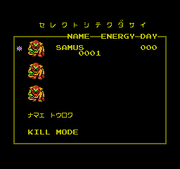
The Samus Data Screen from the FDS version of Metroid.
Prior to the NES release, the game was released in Japan on the Famicom Disk System. Unlike the NES versions, this uses a three-slot save system, similar to the save system used in the Legend of Zelda series, rather than lengthy passwords. In addition, armorless Samus was not included in the FDS version. The FDS version instead adds a money bag image to the save slot, which indicates a completed game.
The FDS version utilizes the system's wavetable sound channel for several sound effects, such as doors opening and larger monsters being hit. One other major sound change was to the "countdown alarm" when Mother Brain dies. In the FDS version, it's a loud screeching siren, while in the NES version, it's a slightly soft "whoop whoop" sound. Five themes in the game also use the wavetable channel, adding an extra instrument to the music. This instrument was removed from the NES version.
Another notable difference between the FDS and NES versions is certain enemies' behavior is much more predictable in the NES version. Because the NES lacks the extra memory provided by the FDS, the behavior of certain enemies in the NES version was simplified. For example, Squeepts in Norfair jump out of the lava at one of three heights. In the FDS version, they can change their height each time they jump (low one jump, then high the next). In the NES version, once the enemy appeared, its jump height would be set to one particular value, and recalculated only when the enemy data leaves memory. This predictability removes a certain level of difficulty from the game.
The Famicom Disk System version also has far less lag than the NES version. This is especially noticeable in boss battles, especially Ridley, as well as much of Tourian. This might be due to the different hardware, as evidenced by the fact that this pattern is noticeable with other NES ports of FDS games as well, such as Zelda II: The Adventure of Link.
Samus Aran's Appearance Fanfare and the Item Acquisition Fanfare in most other Metroid titles were based on the themes from the FDS version of Metroid; however, Metroid: Zero Mission uses a combination of both the FDS and NES music, with the exception of the Escape theme, based on the FDS version, whereas the NES version was extended with a section of the song.
Legacy
A sequel to Metroid was released on the Game Boy titled Metroid II: Return of Samus. Since Metroid, Samus has been a popular video game figure and has appeared in various games. Comics and mangas were spawned based on the popularity of Metroid. A Metroid manga was created to explain the backstory to this series. Tokyopop at one point listed a Metroid manga amongst the list of upcoming books, though it has since disappeared.
Ports
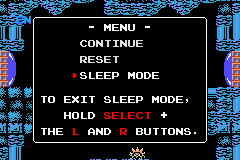
The Menu screen from the Classic NES Series version of Metroid, featuring an option to activate Sleep Mode.
Metroid is present as an unlockable bonus in Metroid Prime. Since Metroid is already available on the Wii's Virtual Console service and included in Metroid Zero Mission, it can no longer be unlocked in the Wii versions. The game was also remade into Metroid: Zero Mission for the Game Boy Advance, which was a retelling of Metroid, though with more plot and areas. Zero Mission also included Metroid as an unlockable bonus, rewarded after completing the remake at least once. Nintendo also re-released the original Metroid for the Game Boy Advance as part of the Classic NES Series (Famicom Mini in Japan and NES Classics in Europe) in 2004. This port received negative reception because it was already available in many other ways, and for free. It added save functionality to replace the password system.
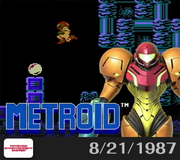
Icon for the Masterpiece in Super Smash Bros. for Wii U.
Metroid was released for the Wii's Virtual Console on August 13, 2007 as part of the "month of Metroid" campaign.[2][3] In 2009, Nintendo of Europe offered a free download of the Virtual Console Metroid to 5,000 Club Nintendo members for registering Metroid Prime Trilogy if they had also previously registered one of the three Prime console games. This game was also released as a game on September 1, 2011 for ambassadors on the Nintendo 3DS Virtual Console. It was released to the general public on the Nintendo eShop on March 1, 2012. The 3DS version of the game has password functionality, and also has a save feature in the form of the "Restore Point" function, which allows players to save the state of their game. The game is present as a Masterpiece in Super Smash Bros. for Wii U.
Metroid is included as one of the 30 games pre-loaded onto the NES Classic Edition, a smaller reproduction of the original NES released on November 11, 2016.[10]
Trivia
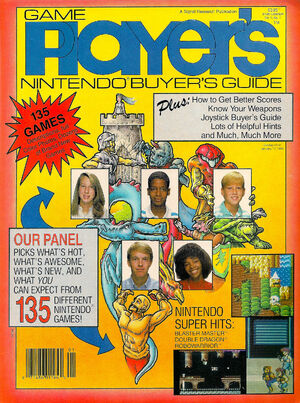
Unlicensed appearance on Game Player's Nintendo Buyer's Guide (Winter 1988 issue)
- Metroid claims to be a "two player alternating game" on its boxart. However, multiplayer was not introduced to the series until Metroid Prime 2: Echoes (although Samus did appear in Super Smash Bros. and Super Smash Bros. Melee).
- If the Start button is not pressed within around 30 seconds, a short (poorly-translated) synopsis of the plot will show on the screen, saying Samus is on planet "Zebeth" instead of "Zebes," as the planet is called in later games:
- "EMERGENCY ORDER
- DEFEAT THE METROID OF
- THE PLANET ZEBETH AND
- DESTROY THE MOTHER BRAIN
- THE MECHANICAL LIFE VEIN
- GALAXY FEDERAL POLICE
- M510"
- Metroid and Kid Icarus are the only two of the five Nintendo published games that contain a NES-SNROM-0x PCB chip that cannot save game data, suggesting that they were intended to at some point like their Japanese counterparts.
- Metroid was originally titled Space Hunter, before it was changed to Metroid, by combining the words android and metro subway.[7]
- The manual and reference card for the U-Force NES peripheral include a chart that suggests playing Metroid in the Mode E (Flat) configuration of the device.
- Metroid has the least amount of boss battles in the entire series, with the total coming to only three, Kraid , Ridley and Mother Brain. Conversely, its direct sequel, Metroid II: Return of Samus (and by extension the remake, Metroid: Samus Returns) has the most amount of boss battles in the series, with over 40.
- Before it grew into its own franchise, Metroid was marketed on its original boxart as part of the "Adventure Series" of NES games. This was one of several "series" or genre categories placed on the bottom left corner of Nintendo game boxart, although this practice did not continue for long. The only other title to be part of the Adventure Series was Metroid's sister game, Kid Icarus.
Gallery
- For concept art, see Metroid's Gallery.
See also
- List of bosses in Metroid
- List of creatures in Metroid
- List of items in Metroid
- Metroid Trucker Cap
- Metroid (1986 manga)
- Metroid: Zebes Invasion Order
- The Shape of Happiness
- Nintendo Comics System
- Captain N: The Game Master
- Metroid (2002 manga)
- Metroid/Staff
- Kid Icarus / Metroid Original Soundtrack Orchestra Version
- Game Sound Museum ~ Famicom Edition ~ 12 Metroid
- Super Metroid: Sound in Action
References
- ^ http://www.nintendo.com/games/detail/hOyRxr3W4yhKWayjsq6c38w_B41MeO_j
- ^ a b Metroid Mania - Metroid Prime 3: Corruption preview channel, Metroid, Super Metroid VC dated - Update. Go Nintendo (2007-08-10). Retrieved on 2007-08-11.
- ^ a b Wii VC Gains Metroid, Shining in the Darkness, Cratermaze. Shacknews (2007-08-13). Retrieved on 2007-08-13.
- ^ (1987) Metroid Instruction Booklet. Nintendo of America, Inc., 3.
- ^ (1991) Metroid II: Return of Samus Instruction Booklet. Nintendo of America, Inc., 3.
- ^ (2004) Metroid Zero Mission Instruction Booklet. Nintendo, 6.
- ^ a b Famicom Disk System: The More You Play It, the More You'll Want to Play!. The Metroid Database. Retrieved on 2011-06-15.
- ^ Legends of Localization: Q&A: Was Samus Called a He in Japanese Too?. Retrieved on 2013-09-21.
- ^ General Metroid FAQ. The Metroid Database. Retrieved on 2006-06-29.
- ^ http://www.cbc.ca/news/technology/nintendo-nes-classic-edition-announce-1.3678865

